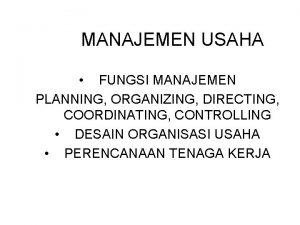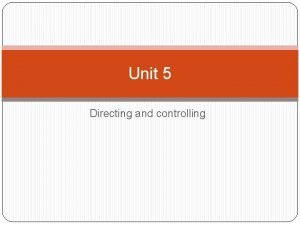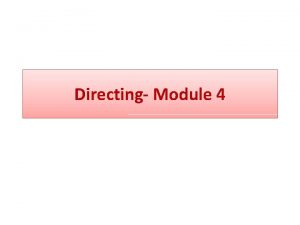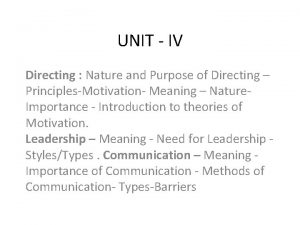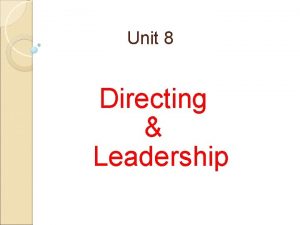Directing and Leading Chapters 7 8 Directing Process















- Slides: 15

Directing and Leading Chapters 7 & 8

Directing • Process of guiding people in their work and ensuring that they do it in the best possible manner • Interpersonal aspect of managing by which subordinates are led to understand contribute effectively to the attainment of enterprise objectives • Involves issuing orders and instructions, overseeing of subordinates and supervising the work performed by them

Characteristics of Directing • • • Initiates action At all levels of management Continuous process Flows from top to bottom Indivisible from other functions of management • Goal oriented

Steps in Directing Defining the objectives Formulating guidelines and Instructions Selecting right subordinates for instructions Issue orders and instructions Motivation Leading Direct Supervision Feedback and follow up

Leadership • Leadership is the ability to secure desirable actions from a group of followers voluntarily, without the use of coercion • Leader shows the way by his own example. He is not a pusher, he pulls rather than pushes. • A leadership style is a leader's style of providing direction, implementing plans, and motivating people

Qualities of a good leader • • Physical features Knowledge Communication skills Integrity and Honesty Motivator Self Confidence Initiative and courage Social skills

Leadership Styles • Autocratic Style: – – Task manager Takes all decisions by himself Does not consult subordinates in decision making Formal relations between superior and subordinate

Leadership Styles • Bureaucratic Style: – Takes decisions by strictly following rules and regulations – Subordinates not consulted – Emphasis is on procedures and historical methods regardless of their usefulness in changing environments – Results in delay

Leadership Styles • Consultative style: – Leader consults the subordinates before making decisions – Subordinates’ suggestions may or may not be accepted – Superior takes the decision – Superior is responsible for the decision – Informal superior and subordinate relationships

Leadership Styles • Participative Style/ Democratic Style: – Superior not only consults his subordinates but also allows them to take part in decision making – Leader also takes part in decision making along with the group – Responsibility of the decision shared by the leader and the group – Informal relations

Leadership Styles • Paternalistic Style: – – – Leader respected and treated as a father figure Followed in Japanese organizations Leader may consult subordinates Leader mostly takes decisions Leader supplies complete concern for his followers or workers – The workers normally stay with a company for a longer period of time because of the loyalty and trust

Leadership Styles • Laissez Faire/ Free rein/ Delegate Style – – Non Interference or influence Complete freedom to subordinates Motivation provided by group members No guidelines provided

Leadership Styles • Charismatic Style – Leader motivates his followers through his charisma – Leader believes in himself /herself more than his/her followers – Followers believe that success is because of the presence of the leader • Situational Style: – Style varies depending on the situation

Leadership Styles • People Oriented Leadership – The exact opposite of task oriented leadership • Servant Leadership – Leads by meeting the needs of the team – Sometimes not even formally recognized as the leader – Leads by example – Shows extraordinary honesty – Leads to high morale among team members

Thanks
 Objectives of roving frame
Objectives of roving frame Principles of directing in management
Principles of directing in management Staffing and directing
Staffing and directing Staffing and directing
Staffing and directing Chapter 4 project integration management
Chapter 4 project integration management Strategy implementation staffing and directing
Strategy implementation staffing and directing The central instrument for directing and coordinating
The central instrument for directing and coordinating Planning organizing leading controlling
Planning organizing leading controlling Planning organizing directing coordinating controlling
Planning organizing directing coordinating controlling Chapter 2 developing marketing strategies and plans ppt
Chapter 2 developing marketing strategies and plans ppt Directing and controlling
Directing and controlling Staffing and controlling
Staffing and controlling Staffing and directing
Staffing and directing Staffing and directing
Staffing and directing What is a polynomial coefficient
What is a polynomial coefficient How to find the degree of a polynomial graph
How to find the degree of a polynomial graph








